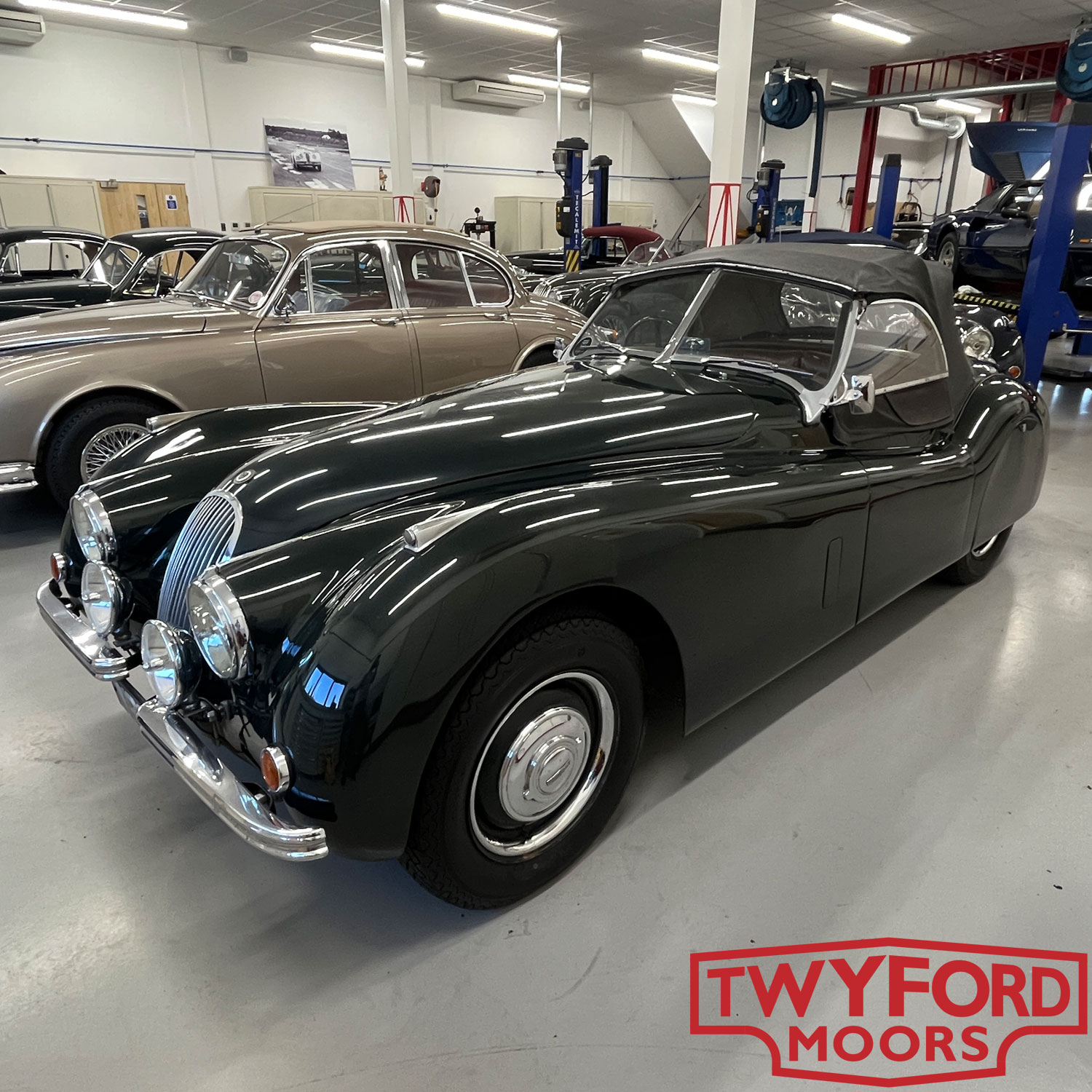From XK120 to F-Pace and Everything In Between – Workshop Update
At the risk of sounding like a broken record, this update is long overdue. Once again, the workshop has been incredibly busy, and we’re very grateful to our customers for their continued patience as we fit their cars into our schedule. Beyond sheer workload, we’ve also had a wonderfully diverse range of vehicles through the doors recently, as you’ll see in the updates to follow.
That said, we remain firmly rooted in our core values: we are, first and foremost, specialists in XK120s, XK140s, XK150s, and E-Types. The photo accompanying this post, featuring a beautiful lineup of XK120s through the centre of the workshop, is a testament to that. These models still represent the majority of our work—even if the variety of other classics featured here might suggest otherwise.
To give you an idea of how busy things have been, at one point in May we counted 37 cars upstairs in storage and a further 16 downstairs—a total of 53 cars on site. That’s the absolute limit of what we can accommodate, and we only ever accept cars we can securely store indoors.
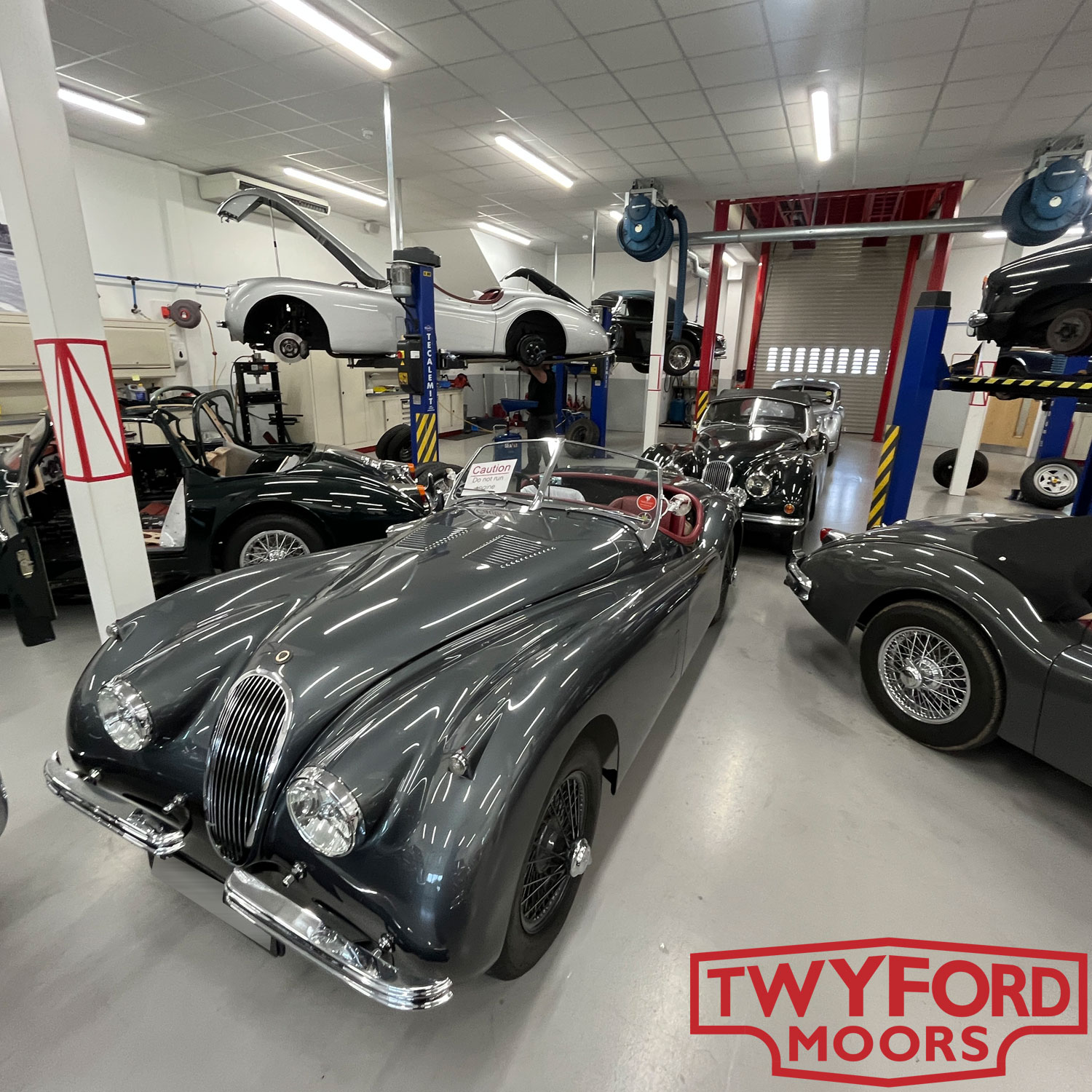
HCVA Heritage Matters Day
A couple of weeks ago we travelled to Bicester Heritage for the HCVA’s Heritage Matters Day, generously hosted by Hagerty at their excellent clubhouse. If you’re not yet familiar, the HCVA (Historic and Classic Vehicles Alliance) is the voice of the UK’s classic vehicle community. It works tirelessly to safeguard the future of the sector—championing heritage, sustainability, technical skills, and regulatory clarity.
In its first few years, the HCVA has made impressive progress, including working closely with the DVLA to resolve and clarify many of the registration issues faced by classic car owners and businesses. Their efforts continue to deliver real benefits for professionals and enthusiasts alike.
Heritage Matters Day brings together over 100 industry figures and offers valuable insight through keynote speeches and panel discussions. Topics range from legislation and sustainable fuels to skills retention, parts quality and EV conversions. This year, we were particularly interested in the DVLA’s updates on classic vehicle registration processes and in hearing HCVA CEO Dale Keller’s vision for the future of the organisation. It’s inspiring to see so much expertise and passion focused on protecting the future of our shared motoring heritage. (Thanks to Gunhill Studios for the image)

LOE 3 – A XK120 with Rallying Heritage
We are fortunate to be entrusted with some truly remarkable XKs here at Twyford Moors. Over the years, we’ve worked on many historically significant cars—including Stirling Moss’s personal XK120 FHC, PPE 101, and MNK 500. The latest to join that illustrious list is LOE 3, a notable XK120 with period rallying history.
LOE 3 was driven by Frank Grounds and Jack Hay in the 1951 Daily Express and RAC Rallies. It’s a car of real pedigree, and it’s a privilege to have it in our care for the first time.
The current owner asked us to inspect and recommission the car for road use. Pleasingly, LOE 3 has clearly been very well maintained over the years. Aside from a very old, hardened set of tyres and a few other minor items, the car required very little to bring it back to fine fettle. With a fresh set of tyres and some finishing touches, it’s now ready to be enjoyed again.
Every car that comes through our doors gets the same care and attention—whether it’s an MG Midget or a historically significant XK like LOE 3. But there’s a particular satisfaction in being trusted with a car of this calibre.
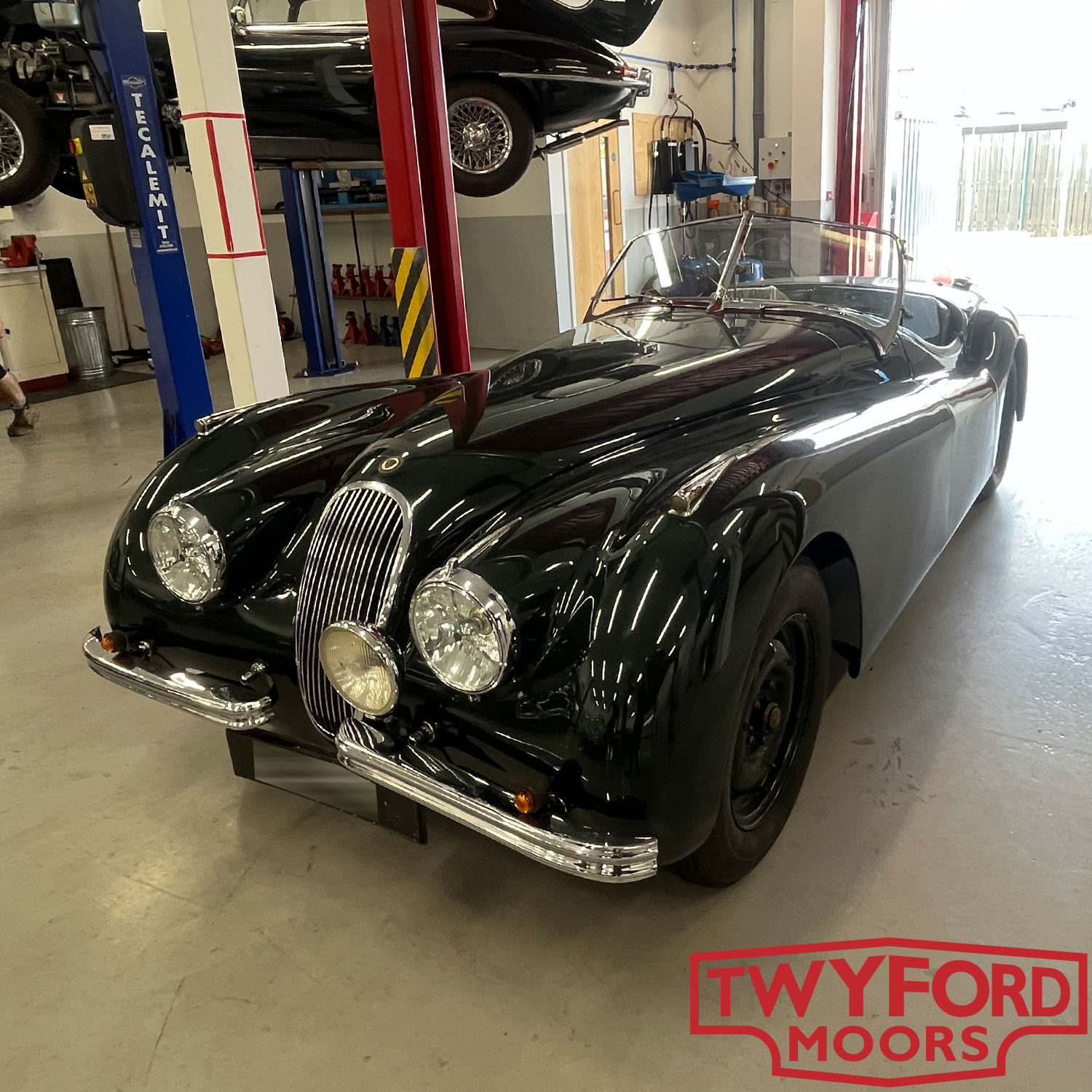
Jaguar F-Pace in the Workshop
We’ve spoken a lot recently about the growing demand for work on 'modern classics'—but having a Jaguar F-Pace in the workshop takes us into far more modern territory than we typically cover. That said, the circumstances make the visit understandable.
It seems that Jaguar’s main dealer network is struggling to keep up with servicing demand, and we’re hearing of long waiting times for appointments. In some cases, older cars from the 2000s and earlier are being turned away in favour of newer models. Locally, the situation is likely made worse by the temporary closure of our nearest Jaguar dealer in Chichester for refurbishment. We’d be very interested to hear if others have had similar experiences.
This particular F-Pace had a leak from an intercooler hose, and waiting until July for Jaguar to investigate simply wasn’t an option. We were happy to step in and resolve the issue quickly. While we're more than capable of handling mechanical repairs like this, there are some electronic diagnostics that require specialist equipment we don’t currently hold.
Even so, we’re always happy to help where we can, and it’s clear that demand for independent expertise in more modern Jaguars is on the rise.

Five-Speed Gearbox Upgrades
Here we have a stunning pair of Jaguars recently ready for collection: a beautiful E-Type and an exceptional MKII. The MKII, in particular, stands out—it’s one of the finest examples we’ve seen, with outstanding restoration quality both above and below. Neither of these are easy or inexpensive cars to restore properly, so it's a credit to the effort and craftsmanship that’s gone into it.
Both were with us for a five-speed gearbox conversion—an increasingly popular upgrade for classic Jaguars. We’ve long offered these gearboxes for XK models, and demand has soared since we began fitting them to E-Types, MKIIs and other Jaguar saloons.
A five-speed gearbox transforms the driving experience. It offers a higher cruising gear for comfortable motorway driving and makes the car far more usable day to day. These gearboxes also tend to be smoother and easier to use—especially when replacing a Moss gearbox, which can be challenging to operate for the uninitiated.
Perhaps best of all, a five-speed upgrade is often more cost-effective than rebuilding a tired original gearbox—and almost always more reliable. If you’re considering upgrading your classic Jaguar for usability and longevity, do get in touch to discuss your options.

A Rare MG Midget with a Story
There’s nearly always a non-Jaguar or two in the workshop, and this lovely MG Midget is a great example. The car belongs to a customer whose E-Type we look after, and he asked if we’d carry out some work on the Midget as well.
Being a later, rubber-bumpered model, this version of the Midget isn’t everyone’s favourite—but this particular car is something special. I understand this car to be a very late MG Midget. Originally supplied to a dealership as a display model, it was used sparingly as a demonstrator before being tucked away into storage for decades.
Later recommissioned, the car remains remarkably original and beautifully preserved. It’s covered just a few thousand miles from new and is in near-pristine condition inside and out. It’s always a treat to see a car with such a well-preserved history.
This visit was for a routine service, though we did uncover a few items requiring attention. It’s often the case that cars used very infrequently need more maintenance than those driven regularly—age and inactivity can be just as taxing as mileage. Still, it’s a pleasure to help ensure this little piece of MG history stays in fine running order.
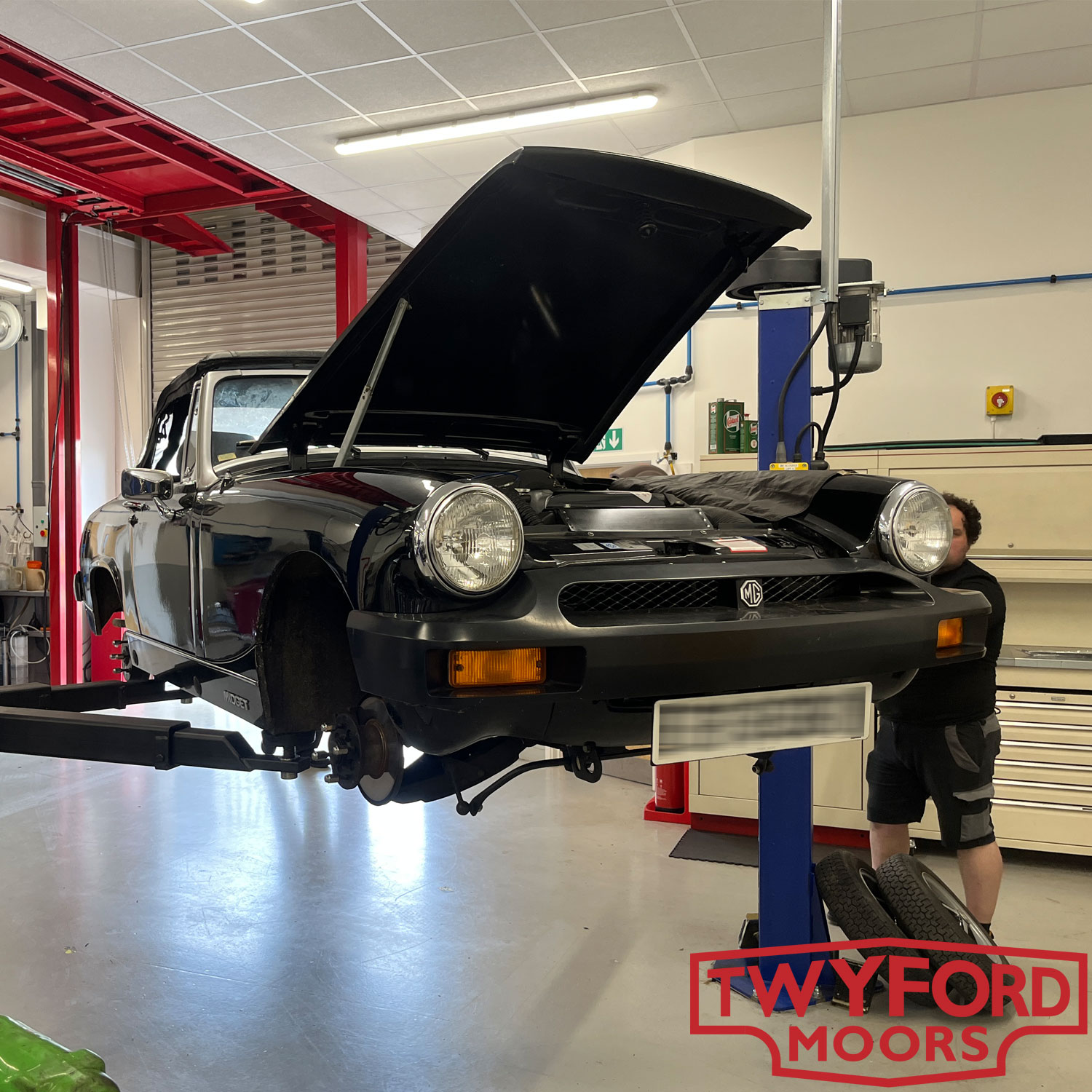
Blue Monday?
I can’t honestly remember whether this photo was taken on a Monday—but the cars are certainly blue! Cotswold Blue is my favourite colour on an XK. It’s particularly striking on an XK150 FHC, where the shape and shade complement each other beautifully. I don’t have an XK in this colour, but I do have a pushbike a similar blue, which will have to do for now.
I’m not entirely sure what the colour is called on the XJ6 pictured here—perhaps one of you knowledgeable folks can enlighten me? I do know this is not an original colour for an XK140, but surely you’ll agree that it suits the car remarkably well.
There’s no deeper purpose to sharing this image beyond enjoying two beautiful Jaguars in what I think is one of the finest colours for either model. Coincidentally, both cars were in for seat work: the XK140 had a pair of our custom bucket seats fitted, while the XJ6 received fresh seat base foam to replace the sagging originals. If you’re going to enjoy a classic Jaguar, you may as well do it in comfort—and style!

Jaguar XJR Recommissioning
Here’s a slightly forlorn-looking Jaguar XJR—specifically, an X300 with the supercharged straight-six engine. For those who like to get technical, the X300 might just be the one to have when it comes to modern classic XJs. There’s something inherently right, at least to us XK enthusiasts, about a Jaguar powered by a straight-six.
This particular car had been off the road for some time and was booked in due to a misfire. However, once it arrived and we began our inspection, it quickly became clear the misfire was just the tip of the iceberg. Several electrical and mechanical faults meant a much more thorough recommissioning will be required. That said, the car is fundamentally sound and well worth saving.
We started with the misfire, which was traced to a failed fuel injector. With the injector replaced and a couple of wiring issues repaired, the XJR is now running smoothly again. We’ve provided the owner with a comprehensive report outlining the work needed to return it to full roadworthy condition, and we’re excited to sink our teeth into the rest of the project.
There’s life in this big cat yet!

Jaguar E-Type Suspension Overhaul
Pictured here is a Jaguar E-Type subframe on the trolley, ready to be refitted to the car you can see in the background. We’re just completing a full suspension overhaul—front and rear—rebuilding it with new shock absorbers, bushes, and anything else it needed.
An E-Type with perished or sagging bushes can lose much of its famed poise. These are wonderfully engineered cars that should ride and handle superbly. But with such an advanced suspension system (for its time), there are plenty of places where wear can creep in and degrade the driving experience.
We typically use polyurethane bushes these days. They last longer than rubber, sharpen up the handling, and don’t noticeably compromise the ride. Often when I post about this, I hear concerns about poly bushes making the ride harsh—but this usually comes from people fitting them to more modern cars. In our experience, classics like the E-Type really benefit from them.
What’s your take? Have you fitted polyurethane bushes to your car, and if so, how did you find the results? We’d love to hear your thoughts.

Jaguar 420 Saloon – A Hidden Gem
Jaguar produced some fascinating saloons in the 1960s before settling into a more consistent design language with the XJ6. However, if you look closely, you can clearly trace the evolution from the Mk1, Mk2, S-Type and 420 through to the XJ6.
Pictured here is a Jaguar 420—not to be confused with the significantly larger 420G. The 420 was essentially a facelifted S-Type with the 4.2-litre engine, and should really be viewed as the final iteration of the ‘compact’ sports saloons, following on from the Mk1 and Mk2. The 420G, by contrast, was effectively a rebranded MkX: a much larger luxury saloon continuing the lineage of the MkVII, MkVIII and MkIX.
The 420, like the S-Type, is a hugely underrated car. They tend to be valued far lower than a Mk2 of similar quality, but in my humble opinion, they’re actually better to drive. Both the S-Type and 420 feature the same independent rear suspension found in the E-Type and later the XJ6, which gives them a significantly more refined ride and sharper handling than the Mk2. The Mk2’s styling is arguably more iconic, but I still think the 420 is a very handsome car—and a bit of a bargain.
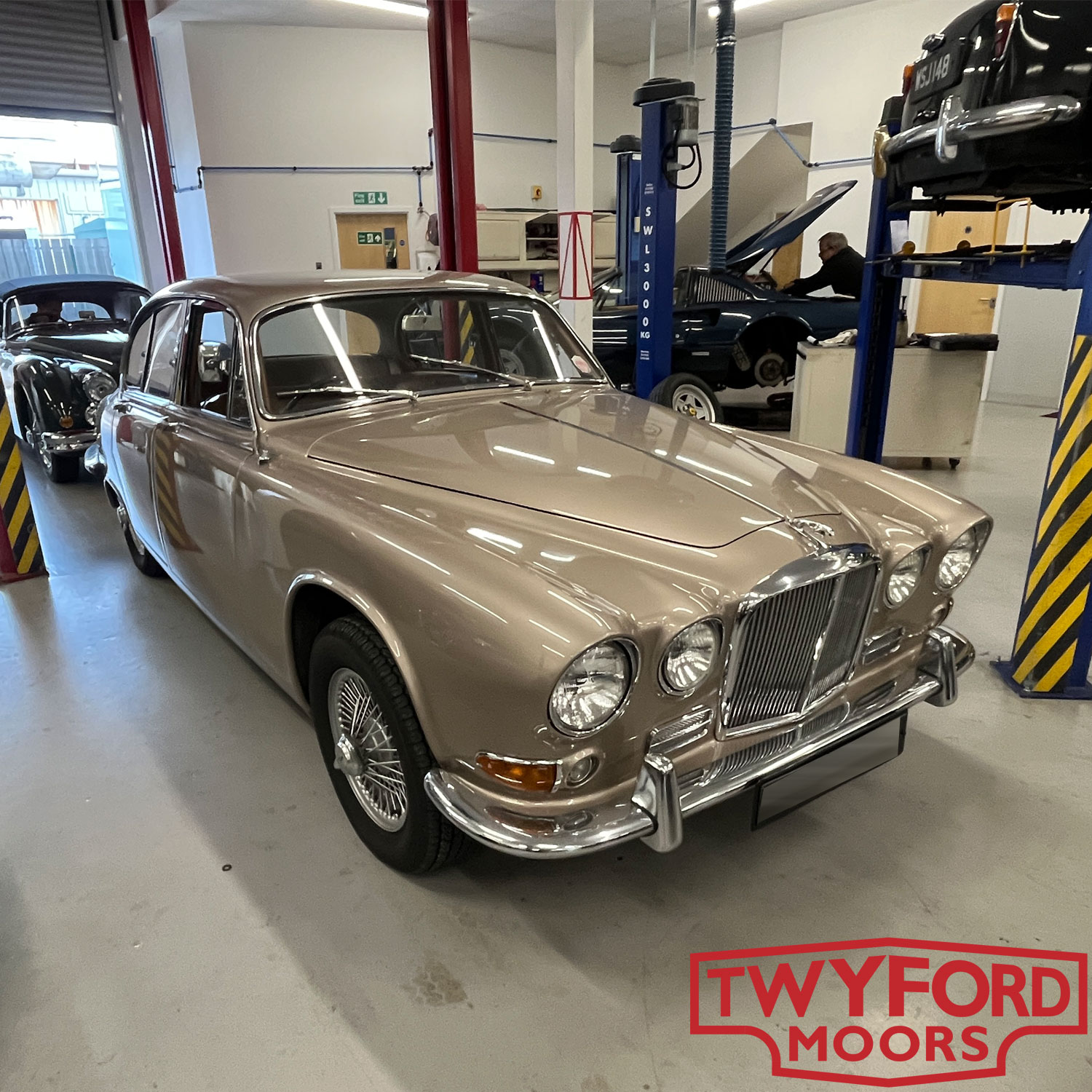
Ferrari 308 – An Unexpected Guest
Here’s another non-Jaguar visitor: a Ferrari 308, owned by a customer whose V12 E-Type we had recently completed an extensive restoration on. Delighted with the results, he’d previously asked if we could look after his Ferrari. We do not generally seek to work on such cars for both technical and practical (they can be so low that they are difficult to get on our ramps) reasons.
However, fate intervened. One Saturday morning, the customer rang—his 308 had broken down locally. I was able to recover it to our workshop and, seeing that it was a 308, knew at least we could get it on a ramp. We’ll always do what we can to help our customers, and this was no exception. Fortunately, one of our technicians has prior experience with Ferraris and even rebuilt a 308 engine some years ago—so we were well placed to take a look.
After resolving the issue that caused the breakdown, we carried out a full service. As is often the case, the road test then revealed further issues that couldn’t have been identified until the car was running properly. We’re now working through a few additional jobs to get this 308 performing as it should.
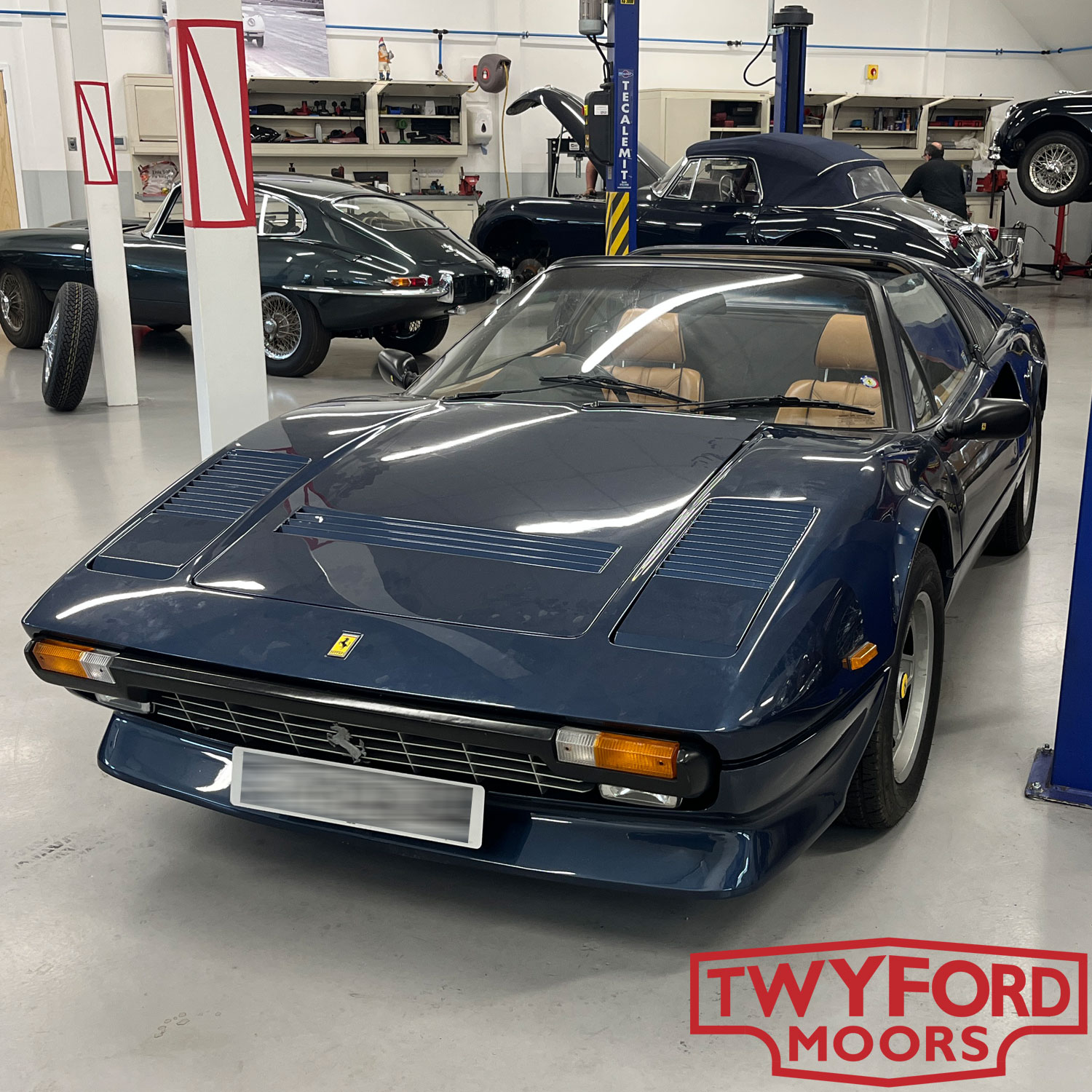
Jaguar XK120 OTS – Well Used, Well Loved
This wonderful Jaguar XK120 OTS is a regular visitor to our workshop. It’s a very well-sorted car mechanically, though it shows its age cosmetically—with worn paint and interior trim from regular use. Personally, I love cars like this. The owner puts plenty of miles on it every year, and it proves our theory that well-used cars tend to need less remedial work than those that sit idle.
As I mentioned in a previous post about a low-mileage MG Midget, cars that are driven regularly tend to reveal and resolve issues as they arise. By contrast, cars that see little use often develop problems that take longer to come to light. Hydraulic systems, in particular, dislike being left static—fluid leaks are more common even in relatively new components when a car isn’t used.
On this visit, the XK120 was in for a routine service and a minor job to clean the points on the time clock, which had stopped working. That said, cleaning is rarely a long-term fix. For a reliable solution, we offer a discreet upgrade that replaces the original points with a modern sensor on the balance wheel—preserving the rest of the original movement while improving reliability.
